Eco-Friendly and Efficient: Discover the Advantages of Self-Cleaning Water Heater
Thinking of upgrading your home's water heating system?
Let me introduce you to a lesser-known but very useful type of water heating systems: the self-cleaning water heater.
Imagine a water heater that not only provides a steady stream of hot water but also takes care of itself, reducing the hassle of maintenance.
These innovative appliances use a unique approach to prevent the buildup of sediment, which means they last longer and work more efficiently, saving you money on energy bills.
Whether you're tired of frequent maintenance or just looking to make a smart home investment, a self-cleaning water heater is definitely worth checking out.
Understanding self-cleaning water heaters

Self-cleaning water heaters are advanced appliances designed to tackle one of the most common problems in standard heating models: sediment buildup.
Over time, minerals in water can accumulate at the bottom of the tank, preventing proper water heating, resulting in decreased efficiency and potentially leading to damage.
Self-cleaning models address this issue by incorporating a system that regularly cleans the tank, ensuring consistent performance. For most households, they typically come in capacities ranging from 30 to 80 gallons, catering to various household sizes.
How they differ from traditional water heaters
Unlike the traditional type, which require manual flushing to remove sediment, self-cleaning water heaters automate this process.
The key difference lies in their built-in mechanism that constantly agitates the water, preventing tiny particles from settling.
This results in a significant reduction in the frequency of maintenance needed.
Additionally, self-cleaning models often boast higher energy efficiency ratings, with some electric models having Energy Factors (EF) upwards of 0.95, compared to traditional models that usually hover around 0.60-0.70 EF.
The technology and mechanisms involved in self-cleaning
The core technology in self-cleaning water heaters is typically a specially designed dip tube or a water jet system.
The dip tube creates a swirling action in the water, which keeps the sediment particles in motion and prevents them from settling at the bottom.
Some models use water jets to create turbulence in the tank.
These systems are often coupled with innovative insulation materials and efficient heating elements, leading to better heat retention and reduced energy consumption.
This technology not only extends the life of the heater but also maintains its efficiency over time, translating to lower utility bills and less frequent need for repairs or replacement.
Benefits of self-cleaning water heaters
Extended lifespan: Self-cleaning water heaters are designed to last longer than traditional models. The primary reason is the reduced sediment buildup, which is a common cause of deterioration in standard water heaters. Regularly removing deposits can extend the life of the water heater by several years.
Lower maintenance: Since these heaters continuously work to prevent sediment accumulation, the need for manual flushing and cleaning is significantly reduced. This means less time and money spent on maintenance, and fewer worries about potential malfunctions caused by mineral deposits.
Higher efficiency: By preventing the buildup, self-cleaning water heaters maintain their efficiency over time. Sediment can act as an insulator, causing the heater to work harder and use more energy to heat water. By keeping the heating element, including the bottom of the tank clean, these water heaters operate more efficiently.
Energy savings: Thanks to their maintained efficiency, self-cleaning heaters can lead to noticeable energy savings. Many models come with high Uniform Energy Factor (UEF) ratings, indicating better overall energy efficiency. Over time, these savings can be substantial, offsetting the initial higher cost of the unit.
Consistent water quality: With less sludge in the tank, the risk of water getting contaminated or discolored is significantly reduced. This means cleaner, clearer water for daily use.
Prevention of sediment buildup: The self-cleaning function actively prevents residues from settling at the bottom of the tank. This is especially beneficial in areas with hard water, where mineral deposits are more common. By keeping the tank clean, these heaters ensure optimal performance and prevent issues like uneven heating or popping noises often associated with sediment buildup.
Considerations when choosing a self-cleaning water heater
Determining size: The size of the water heater should be based on the number of occupants and water usage patterns. A general guideline is to allocate about 10-15 gallons per person in the household. For example, a family of four might need a 40-60 gallon tank.
Specs to consider: Larger tanks (40-80 gallons) are common, but it's crucial to balance size with demand to avoid inefficiency.
Understanding UEF ratings: Uniform Energy Factor (UEF) is a key metric indicating a water heater's efficiency. The higher the UEF, the more efficient the heater. Self-cleaning models often have higher UEF ratings than standard models.
Typical ratings: Electric models can have UEF ratings from around 0.90 to 0.95 or higher, while gas models range from 0.60 to 0.70 and above.
Cost vs. savings: Higher UEF models may cost more upfront but offer significant energy savings in the long run.
Plumbing requirements: Ensure the water heater is compatible with your home’s existing plumbing. This includes checking for the right type and size of water connections and adequate space for installation.
Electrical and gas considerations: For electric models, check your home's electrical system capacity. For gas models, ensure that you have the proper venting and gas line infrastructure.
Upfront costs: Self-cleaning water heaters generally cost more than standard models. Prices can vary widely depending on size, efficiency, and features, with a range typically between $500 to $2000.
Long-term savings: The higher initial investment can be offset by reduced energy bills and lower maintenance costs. Additionally, the longer lifespan of self-cleaning models means fewer replacements over time.
Rebates and incentives: Look for potential rebates and incentives for energy-efficient models, which can help lower the initial cost.
Exploring the advanced self-cleaning features across leading water heater brands
Different self-cleaning features in water heaters vary by brand and model, each bringing unique technologies to reduce sediment buildup and maintain efficiency.
Let's explore some of these features across various brands:
Rheem's EverKleen™ Self Cleaning System involves a patented technology where a high-velocity spiraling water stream helps prevent sediment build-up. This system enhances tank life and maintains the heater's efficiency over time.
AO Smith's DynaClean™ Diffuser System involves a dip tube designed to create a turbulent flow of water inside the tank, helping to prevent minerals from settling.
Bradford White's Hydrojet® Total Performance System uses strategically placed jets to create a turbulent flow of water. It effectively reduces sediment accumulation, ensuring efficient operation and prolonging tank life.
So, are self-cleaning water heaters worth it?
Self-cleaning water heaters stand out as a remarkable advancement in home heating technology, offering a blend of efficiency, convenience, and sustainability.
They are designed to combat sediment buildup, not only extend the lifespan of the unit but also maintain high energy efficiency, leading to reduced energy costs and environmental impact.
When choosing a self-cleaning water heater, homeowners should consider factors like size and capacity, energy efficiency ratings, compatibility with existing home systems, and the balance between upfront costs and long-term savings.
Brands like Rheem, AO Smith, and Bradford White offer a range of models, each with unique features and technologies.
User reviews and expert opinions are invaluable resources in this decision-making process, providing insights into the performance and reliability of different models.
Additionally, the environmental benefits of these water heaters, such as their contribution to reducing greenhouse gas emissions and compatibility with renewable energy sources, make them an excellent choice for eco-conscious consumers.
Overall, self-cleaning water heaters represent not just an appliance upgrade but a smart, long-term investment in your home's efficiency and your commitment to a sustainable lifestyle.



